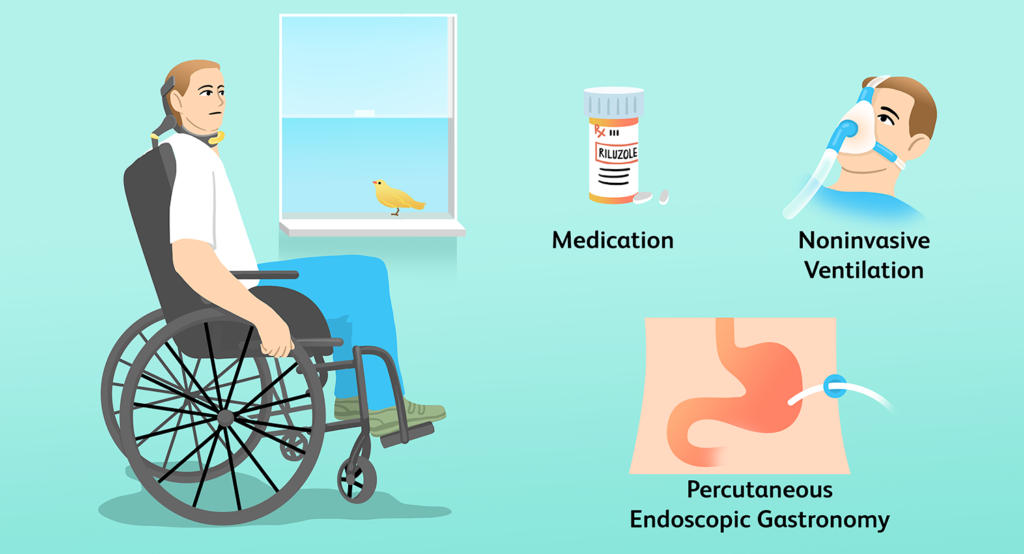What is Lou Gehrig’s Disease (ALS)? Lou Gehrig’s disease, also known as amyotrophic lateral sclerosis (ALS), is a progressive neurodegenerative disorder that affects nerve cells in the brain and spinal cord. ALS leads to the deterioration of motor neurons, which are responsible for controlling voluntary muscle movement. As the disease progresses, individuals with ALS gradually lose the ability to initiate and control muscle movement, leading to muscle weakness, paralysis, and eventually respiratory failure.
Symptoms of ALS:
- Muscle Weakness: Weakness in the arms, legs, hands, and feet, which may initially manifest as difficulty with fine motor tasks like gripping objects or walking.
- Muscle Twitching: Fasciculations or muscle twitching, particularly in the arms, legs, and tongue.
- Muscle Stiffness: Increased muscle stiffness and stiffness in the limbs, making movement more challenging.
- Difficulty Speaking: Speech difficulties, such as slurred speech or difficulty projecting the voice.
- Swallowing Problems: Difficulty swallowing (dysphagia) due to weakened muscles in the throat and mouth.
- Muscle Cramps: Painful muscle cramps or spasms, especially in the legs and feet.
- Unintended Weight Loss: Weight loss and muscle atrophy due to decreased physical activity and difficulty eating.
- Breathing Difficulties: Respiratory problems, including shortness of breath and difficulty breathing, particularly in the later stages of the disease.
Causes of ALS: The exact cause of ALS is not fully understood, but it is believed to be multifactorial, involving a combination of genetic and environmental factors. Some potential factors associated with ALS include:
- Genetic Mutations: Inherited genetic mutations, particularly in genes such as C9orf72, SOD1, TARDBP, and FUS, have been linked to familial cases of ALS.
- Environmental Exposures: Exposure to certain environmental toxins or substances, such as lead or pesticides, may increase the risk of developing ALS.
- Neuroinflammation: Chronic neuroinflammation and immune system dysfunction may contribute to the degeneration of motor neurons in ALS.
Diagnosis of ALS: Diagnosing ALS can be challenging due to its similarity to other neurological conditions. The diagnostic process typically involves:
- Clinical Assessment: A thorough medical history and neurological examination to evaluate symptoms and assess muscle strength, reflexes, and coordination.
- Electromyography (EMG): EMG testing measures electrical activity in muscles and can help identify patterns of muscle weakness and nerve damage associated with ALS.
- Nerve Conduction Studies: Nerve conduction studies may be performed alongside EMG to evaluate the function of peripheral nerves.
- Imaging Studies: Magnetic resonance imaging (MRI) or computed tomography (CT) scans may be used to rule out other conditions and assess the brain and spinal cord for abnormalities.
Treatment of ALS: Currently, there is no cure for ALS, and treatment aims to manage symptoms, slow disease progression, and improve quality of life. Treatment options may include:
- Medications: Medications such as riluzole and edaravone may be prescribed to slow the progression of ALS and reduce symptoms.
- Physical Therapy: Physical therapy and occupational therapy can help maintain muscle function, improve mobility, and enhance independence.
- Assistive Devices: Assistive devices such as wheelchairs, braces, and communication devices can help individuals with ALS manage daily activities and maintain communication.
- Respiratory Support: As ALS progresses, respiratory support may be necessary to assist with breathing and prevent respiratory failure.
- Nutritional Support: A balanced diet and nutritional supplements may be recommended to prevent weight loss and maintain optimal nutrition.
Conclusion: ALS is a devastating neurological disease that progressively impairs muscle function and ultimately leads to paralysis and respiratory failure. While there is currently no cure for ALS, ongoing research efforts aim to better understand the underlying mechanisms of the disease and develop more effective treatments. Early diagnosis, multidisciplinary care, and supportive interventions can help improve the quality of life for individuals living with ALS and their families.




